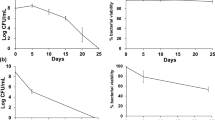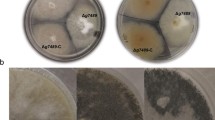Abstract
The culture supernatant of Caldariomyces fumago strains grown in a minimal medium with fructose contains mainly the biotechnologically relevant enzyme chloroperoxidase (CPO) and only minor amounts of other proteins. Our approach to identify the nature of these proteins via peptide mass fingerprinting and transcriptome analysis demonstrated the presence of putative glycosyl hydrolase and glucose oxidase (GOx) enzymes. These activities had been described earlier as parts of the fungus´ halogenation machinery, as they provide CPO with the co-substrate H2O2. The GOx activity was found to have a pH optimum of 5. Compared to the wild type values, GOx activity and glucose-driven MCD chlorination activity in the culture of a white mutant were found to be strongly increased to values of 1–2 U mL−1. As most CPO-catalyzed peroxidation reactions also show pH optima at around 5, the C. fumago culture supernatant can provide a highly convenient CPO/GOx source for many reactions with in situ H2O2 production.
Graphical Abstract





Similar content being viewed by others
References
Ayala M, Batista CV, Vazquez-Duhalt R (2011) Heme destruction, the main molecular event during the peroxide-mediated inactivation of chloroperoxidase from Caldariomyces fumago. J Biol Inorg Chem 16:63–68
Bader O, Krauke Y, Hube B (2008) Processing of predicted substrates of fungal Kex2 proteinases from Candida albicans, C. glabrata, Saccharomyces cerevisiae and Pichia pastoris. BMC Microbiol 8:116
Borole A, Dai S, Cheng CL, Rodriguez M Jr, Davison BH (2004) Performance of chloroperoxidase stabilization in mesoporous sol-gel glass using in situ glucose oxidase peroxide generation. Appl Biochem Biotechnol 113–116:273–285
Buchhaupt M, Hüttmann S, Schrader J (2012) White mutants of chloroperoxidase-secreting Caldariomyces fumago as superior production strains, revealing an interaction between pigmentation and enzyme secretion. Appl Environ Microbiol 78:5923–5925
Buchhaupt M, Hüttmann S, Sachs CC, Bormann S, Hannappel A, Schrader J (2015) Caldariomyces fumago DSM1256 contains two chloroperoxidase genes, both encoding secreted and active enzymes. J Mol Microbiol Biotechnol 25:237–243
Carmichael RD, Pickard MA (1989) Continuous and batch production of chloroperoxidase by mycelial pellets of Caldariomyces fumago in an airlift fermentor. Appl Environ Microbiol 55:17–20
Carmichael RD, Jones A, Pickard MA (1986) Semicontinuous and continuous production of chloroperoxidase by Caldariomyces fumago immobilized in κ-carrageenan. Appl Environ Microbiol 51:276–280
Cavener DR (1992) GMC oxidoreductases. A newly defined family of homologous proteins with diverse catalytic activities. J Mol Biol 223:811–814
Dijkman WP, de Gonzalo G, Mattevi A, Fraaije MW (2013) Flavoprotein oxidases: classification and applications. Appl Microbiol Biotechnol 97:5177–5188
Dunn BM, Hung S (2000) The two sides of enzyme-substrate specificity: lessons from the aspartic proteinases. Biochim et Biophys acta 1477:231–240
Hager LP (2010) A lifetime of playing with enzymes. J Biol Chem 285:14852–14860
Hager LP, Morris DR, Brown FS, Eberwein H (1966) Chloroperoxidase: II. Utilization of halogen anions. J Biol Chem 241:1769–1777
Harms H, Schlosser D, Wick LY (2011) Untapped potential: exploiting fungi in bioremediation of hazardous chemicals. Nat Rev Microbiol 9:177–192
Henrissat B, Davies G (1997) Structural and sequence-based classification of glycoside hydrolases. Curr Opin Struct Biol 7:637–644
Hofrichter M, Ullrich R (2006) Heme-thiolate haloperoxidases: versatile biocatalysts with biotechnological and environmental significance. Appl Microbiol Biotechnol 71:276–288
Huettmann S, Buchhaupt M, Schrader J (2013) Identification of a Caldariomyces fumago mutant secreting an inactive form of chloroperoxidase lacking the heme group and N-glycans. PLoS ONE 8:e67857
Jung D, Streb C, Hartmann M (2010) Covalent Anchoring of chloroperoxidase and glucose oxidase on the mesoporous molecular sieve SBA-15. Int J Mol Sci 11:762–778
Kall L, Krogh A, Sonnhammer EL (2004) A combined transmembrane topology and signal peptide prediction method. J Mol Biol 338:1027–1036
Kaup BA, Piantini U, Wuest M, Schrader J (2007) Monoterpenes as novel substrates for oxidation and halo-hydroxylation with chloroperoxidase from Caldariomyces fumago. Appl Microbiol Biotechnol 73:1087–1096
Kaup BA, Ehrich K, Pescheck M, Schrader J (2008) Microparticle-enhanced cultivation of filamentous microorganisms: increased chloroperoxidase formation by Caldariomyces fumago as an example. Biotechnol Bioeng 99:491–498
Kellner H, Pecyna MJ, Buchhaupt M, Ullrich R, Hofrichter M (2016) Draft genome sequence of the chloroperoxidase-producing fungus Caldariomyces fumago Woronichin DSM1256. Genome Announc 4:e00774
Krieg T, Huettmann S, Mangold K-M, Schrader J, Holtmann D (2011) Gas diffusion electrode as novel reaction system for an electro-enzymatic process with chloroperoxidase. Green Chem 13:2686–2689
Lütz S, Steckhan E, Liese A (2004) First asymmetric electroenzymatic oxidation catalyzed by a peroxidase. Electrochem Commun 6:583–587
Lütz S, Vuorilehto K, Liese A (2007) Process development for the electroenzymatic synthesis of (R)-methylphenylsulfoxide by use of a 3-dimensional electrode. Biotechnol Bioeng 98:525–534
Morris DR, Hager LP (1966) Chloroperoxidase I. Isolation and properties of the crystalline glycoprotein. J Biol Chem 241:1763–1768
Ohtaki S et al (2006) Novel hydrophobic surface binding protein, HsbA, produced by Aspergillus oryzae. Appl Environ Microbiol 72:2407–2413
Osborne RL, Raner GM, Hager LP, Dawson JH (2006) C. fumago chloroperoxidase is also a dehaloperoxidase: oxidative dehalogenation of halophenols. J Am Chem Soc 128:1036–1037
Pickard MA (1981) A defined growth medium for the production of chloroperoxidase by Caldariomyces fumago. Can J Microbiol 27:1298–1305
Popiel S, Nawała J (2013) Detoxification of sulfur mustard by enzyme-catalyzed oxidation using chloroperoxidase. Enzyme Microb Technol 53:295–301
Sambrook J, Russell DW (2001) Molecular cloning—a laboratory manual, 3rd edn. Cold Spring Harbor, Cold Spring Harbor Laboratory Press, New York
Santhanam L, Dordick JS (2002) Chloroperoxidase-catalyzed epoxidation of styrene in aqueous and nonaqueous media. Biocatal Biotransform 20:265–274
Seelbach K (1997) Chloroperoxidase: Ein industrieller Katalysator? PhD thesis, University of Bonn, Germany
Shaw PD, Hager LP (1959a) Biological chlorination IV. Peroxidative nature of enzymatic chlorination. J Am Chem Soc 81:6527–6528
Shaw PD, Hager LP (1959b) Biological chlorination. III. ß-Ketoadipate chlorinase: a soluble enzyme system. J Biol Chem 234:2565–2569
Shaw PD, Hager LP (1961) Biological chlorination. VI. Chloroperoxidase: a component of the ß-ketoadipate chlorinase system. J Biol Chem 236:1626–1630
Shaw PD, Beckwith JR, Hager LP (1959) Biological chlorination. II. The biosynthesis of 5-chlorolevulinic acid. J Biol Chem 234:2560–2564
Singh H (2006) Fungal metabolism of polycyclic aromatic hydrocarbons. In: Mycoremediation. Wiley, Hoboken, pp 283–356
Spreti N, Germani R, Incani A, Savelli G (2004) Stabilization of chloroperoxidase by polyethylene glycols in aqueous media: kinetic studies and synthetic. Appl Biotechnol Prog 20:96–101
Thiel D, Doknić D, Deska J (2014) Enzymatic aerobic ring rearrangement of optically active furylcarbinols. Nat Commun 5:5278
van Deurzen MPJ, van Rantwijk F, Sheldon RA (1997) Chloroperoxidase-catalyzed oxidation of 5-hydroxymethylfurfural. J Carbohydr Chem 16:299–309
van de Velde F, Lourenco ND, Bakker M, van Rantwijk F, Sheldon RA (2000) Improved operational stability of peroxidases by coimmobilization with glucose oxidase. Biotechnol Bioeng 69:286–291
Vazquez-Duhalt R, Ayala M, Marquez-Rocha FJ (2001) Biocatalytic chlorination of aromatic hydrocarbons by chloroperoxidase of. Caldariomyces fumago. Phytochemistry 58:929–933
Wong CM, Wong KH, Chen XD (2008) Glucose oxidase: natural occurrence, function, properties and industrial applications. Appl Microbiol Biotechnol 78:927–938
Yazbik V, Ansorge-Schumacher M (2010) Fast and efficient purification of chloroperoxidase from C. fumago. Process Biochem 45:279–283
Author information
Authors and Affiliations
Corresponding author
Rights and permissions
About this article
Cite this article
Buchhaupt, M., Lintz, K., Hüttmann, S. et al. Partial secretome analysis of Caldariomyces fumago reveals extracellular production of the CPO co-substrate H2O2 and provides a coproduction concept for CPO and glucose oxidase. World J Microbiol Biotechnol 34, 24 (2018). https://doi.org/10.1007/s11274-017-2407-2
Received:
Accepted:
Published:
DOI: https://doi.org/10.1007/s11274-017-2407-2




